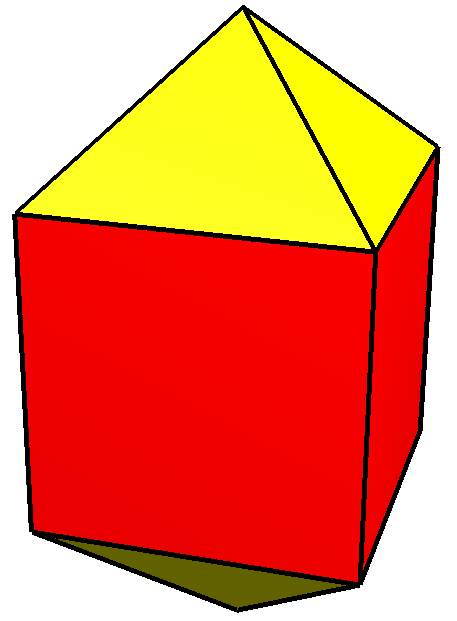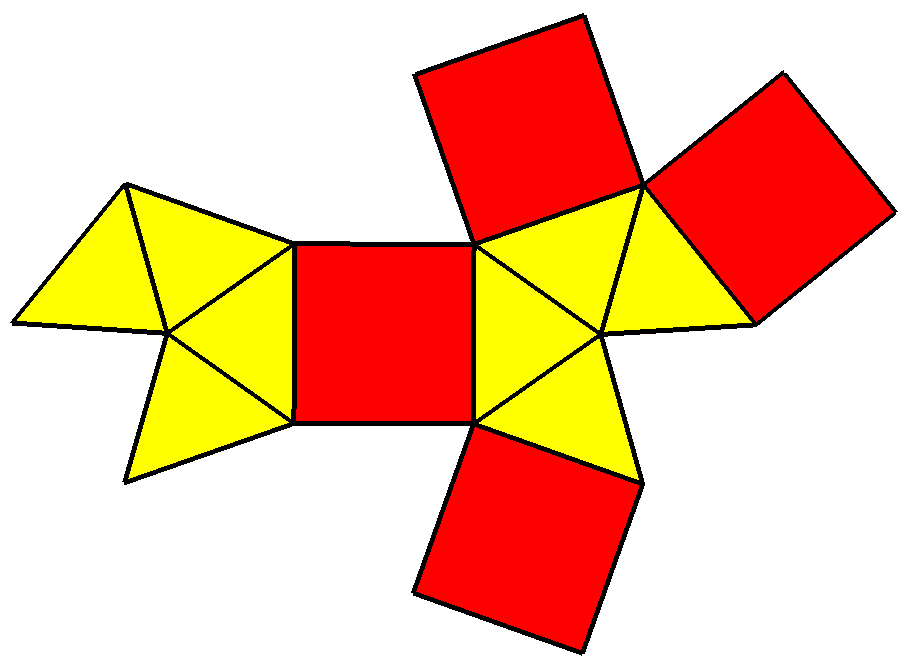Elongated Square Dipyramid on:
[Wikipedia]
[Google]
[Amazon]
In
 The elongated square bipyramid has the
The elongated square bipyramid has the

 It can be considered a transitional phase between the
It can be considered a transitional phase between the  Cross-sections of the honeycomb, through cell centers, produce a
Cross-sections of the honeycomb, through cell centers, produce a
geometry
Geometry (; ) is a branch of mathematics concerned with properties of space such as the distance, shape, size, and relative position of figures. Geometry is, along with arithmetic, one of the oldest branches of mathematics. A mathematician w ...
, the elongated square bipyramid (or elongated octahedron) is the polyhedron constructed by attaching two equilateral square pyramids onto a cube
A cube or regular hexahedron is a three-dimensional space, three-dimensional solid object in geometry, which is bounded by six congruent square (geometry), square faces, a type of polyhedron. It has twelve congruent edges and eight vertices. It i ...
's faces that are opposite each other. It can also be seen as 4 lunes (squares with triangles on opposite sides) linked together with squares to squares and triangles to triangles. It is also been named the pencil cube or 12-faced pencil cube due to its shape.
A zircon
Zircon () is a mineral belonging to the group of nesosilicates and is a source of the metal zirconium. Its chemical name is zirconium(IV) silicate, and its corresponding chemical formula is Zr SiO4. An empirical formula showing some of th ...
crystal is an example of an elongated square bipyramid.
Construction
The elongated square bipyramid is constructed by attaching two equilateral square pyramids onto the faces of acube
A cube or regular hexahedron is a three-dimensional space, three-dimensional solid object in geometry, which is bounded by six congruent square (geometry), square faces, a type of polyhedron. It has twelve congruent edges and eight vertices. It i ...
that are opposite each other, a process known as elongation. This construction involves the removal of those two squares and replacing them with those pyramids, resulting in eight equilateral triangles
An equilateral triangle is a triangle in which all three sides have the same length, and all three angles are equal. Because of these properties, the equilateral triangle is a regular polygon, occasionally known as the regular triangle. It is the ...
and four squares as their faces.. A convex polyhedron in which all of its faces are regular is a Johnson solid
In geometry, a Johnson solid, sometimes also known as a Johnson–Zalgaller solid, is a convex polyhedron whose faces are regular polygons. They are sometimes defined to exclude the uniform polyhedrons. There are ninety-two Solid geometry, s ...
, and the elongated square bipyramid is one of them, denoted as , the fifteenth Johnson solid.
Properties
Given that is the edge length of an elongated square bipyramid. The height of an elongated square pyramid can be calculated by adding the height of two equilateral square pyramids and a cube. The height of a cube is the same as the given edge length , and the height of an equilateral square pyramid is . Therefore, the height of an elongated square bipyramid is: Its surface area can be calculated by adding all the area of eight equilateral triangles and four squares: Its volume is obtained by slicing it into two equilateral square pyramids and a cube, and then adding them: Its dihedral angle can be obtained in a similar way as theelongated square pyramid
In geometry, the elongated square pyramid is a convex polyhedron constructed from a cube by attaching an equilateral square pyramid onto one of its faces. It is an example of Johnson solid.
Construction
The elongated square pyramid is a comp ...
, by adding the angle of square pyramids and a cube:
* The dihedral angle of an elongated square bipyramid between two adjacent triangles is the dihedral angle of an equilateral triangle between its lateral faces,
* The dihedral angle of an elongated square bipyramid between two adjacent squares is the dihedral angle of a cube between those,
* The dihedral angle of an equilateral square pyramid between square and triangle is . Therefore, the dihedral angle of an elongated square bipyramid between triangle-to-square, on the edge where the equilateral square pyramids attach the cube, is
dihedral symmetry
In mathematics, a dihedral group is the group of symmetries of a regular polygon, which includes rotations and reflections. Dihedral groups are among the simplest examples of finite groups, and they play an important role in group theory, g ...
, the dihedral group
In mathematics, a dihedral group is the group (mathematics), group of symmetry, symmetries of a regular polygon, which includes rotational symmetry, rotations and reflection symmetry, reflections. Dihedral groups are among the simplest example ...
of order eight: it has an axis of symmetry
An axis (: axes) may refer to:
Mathematics
*A specific line (often a directed line) that plays an important role in some contexts. In particular:
** Coordinate axis of a coordinate system
*** ''x''-axis, ''y''-axis, ''z''-axis, common names f ...
passing through the apices of square pyramids and the center of a cube, and its appearance is symmetrical by reflecting across a horizontal plane. It is symmetrical by reflecting over three mutually orthogonal planes.
Related polyhedra and honeycombs
The elongated square bipyramid is dual to thesquare bifrustum
In geometry, an -agonal bifrustum is a polyhedron composed of three parallel planes of polygon, -agons, with the middle plane largest and usually the top and bottom congruent.
It can be constructed as two congruent frustum, frusta combined acros ...
, which has eight trapezoidals and two squares.
A special kind of elongated square bipyramid ''without'' all regular faces allows a self-tessellation of Euclidean space. The triangles of this elongated square bipyramid are ''not'' regular; they have edges in the ratio 2::.
:
 It can be considered a transitional phase between the
It can be considered a transitional phase between the cubic
Cubic may refer to:
Science and mathematics
* Cube (algebra), "cubic" measurement
* Cube, a three-dimensional solid object bounded by six square faces, facets or sides, with three meeting at each vertex
** Cubic crystal system, a crystal system w ...
and rhombic dodecahedral honeycomb
The rhombic dodecahedral honeycomb (also dodecahedrille) is a space-filling tessellation (or honeycomb) in Euclidean 3-space. It is the Voronoi diagram of the face-centered cubic sphere-packing, which has the densest possible packing of equal s ...
s. Here, the cells are colored white, red, and blue based on their orientation in space. The square pyramid
In geometry, a square pyramid is a Pyramid (geometry), pyramid with a square base and four triangles, having a total of five faces. If the Apex (geometry), apex of the pyramid is directly above the center of the square, it is a ''right square p ...
''caps'' have shortened isosceles triangle faces, with six of these pyramids meeting together to form a cube. The dual of this honeycomb is composed of two kinds of octahedra (regular octahedra and triangular antiprisms), formed by superimposing octahedra into the cuboctahedra of the rectified cubic honeycomb
The cubic honeycomb or cubic cellulation is the only proper regular space-filling tessellation (or honeycomb) in Euclidean 3-space made up of cubic cells. It has 4 cubes around every edge, and 8 cubes around each vertex. Its vertex figure is a re ...
. Both honeycombs have a symmetry of .
chamfered square tiling
In geometry, the chamfered square tiling or semitruncated square tiling is a tiling of the Euclidean plane. It is a square tiling with each edge Chamfer (geometry), chamfered into new hexagonal faces.
It can also be seen as the intersection of tw ...
, with flattened horizontal and vertical hexagons, and squares on the perpendicular polyhedra.
With regular faces, the elongated square bipyramid can form a tessellation of space
In geometry, a honeycomb is a ''space filling'' or ''close packing'' of polyhedral or higher-dimensional ''cells'', so that there are no gaps. It is an example of the more general mathematical ''tiling'' or ''tessellation'' in any number of dime ...
with tetrahedra
In geometry, a tetrahedron (: tetrahedra or tetrahedrons), also known as a triangular pyramid, is a polyhedron composed of four triangular Face (geometry), faces, six straight Edge (geometry), edges, and four vertex (geometry), vertices. The tet ...
and octahedra
In geometry, an octahedron (: octahedra or octahedrons) is any polyhedron with eight faces. One special case is the regular octahedron, a Platonic solid composed of eight equilateral triangles, four of which meet at each vertex. Many types of i ...
. (The octahedra can be further decomposed into square pyramid
In geometry, a square pyramid is a Pyramid (geometry), pyramid with a square base and four triangles, having a total of five faces. If the Apex (geometry), apex of the pyramid is directly above the center of the square, it is a ''right square p ...
s.) This honeycomb can be considered an elongated version of the tetrahedral-octahedral honeycomb
The tetrahedral-octahedral honeycomb, alternated cubic honeycomb is a quasiregular space-filling tessellation (or honeycomb) in Euclidean 3-space. It is composed of alternating regular octahedra and tetrahedra in a ratio of 1:2.
Other names inc ...
.
References
External links
* {{Johnson solids navigator Johnson solids Bipyramids